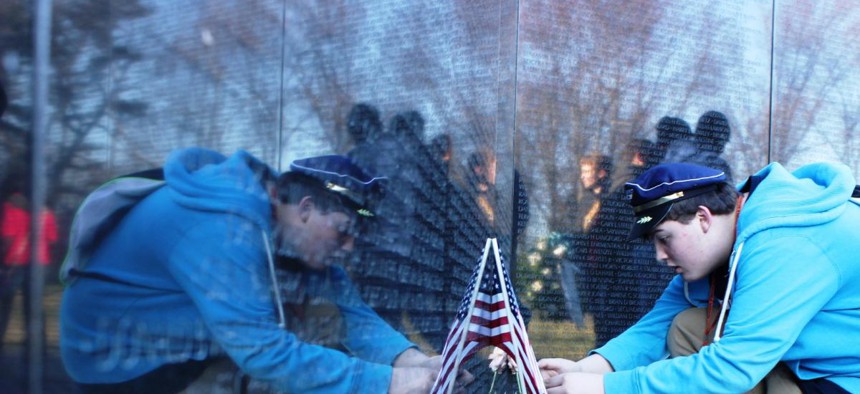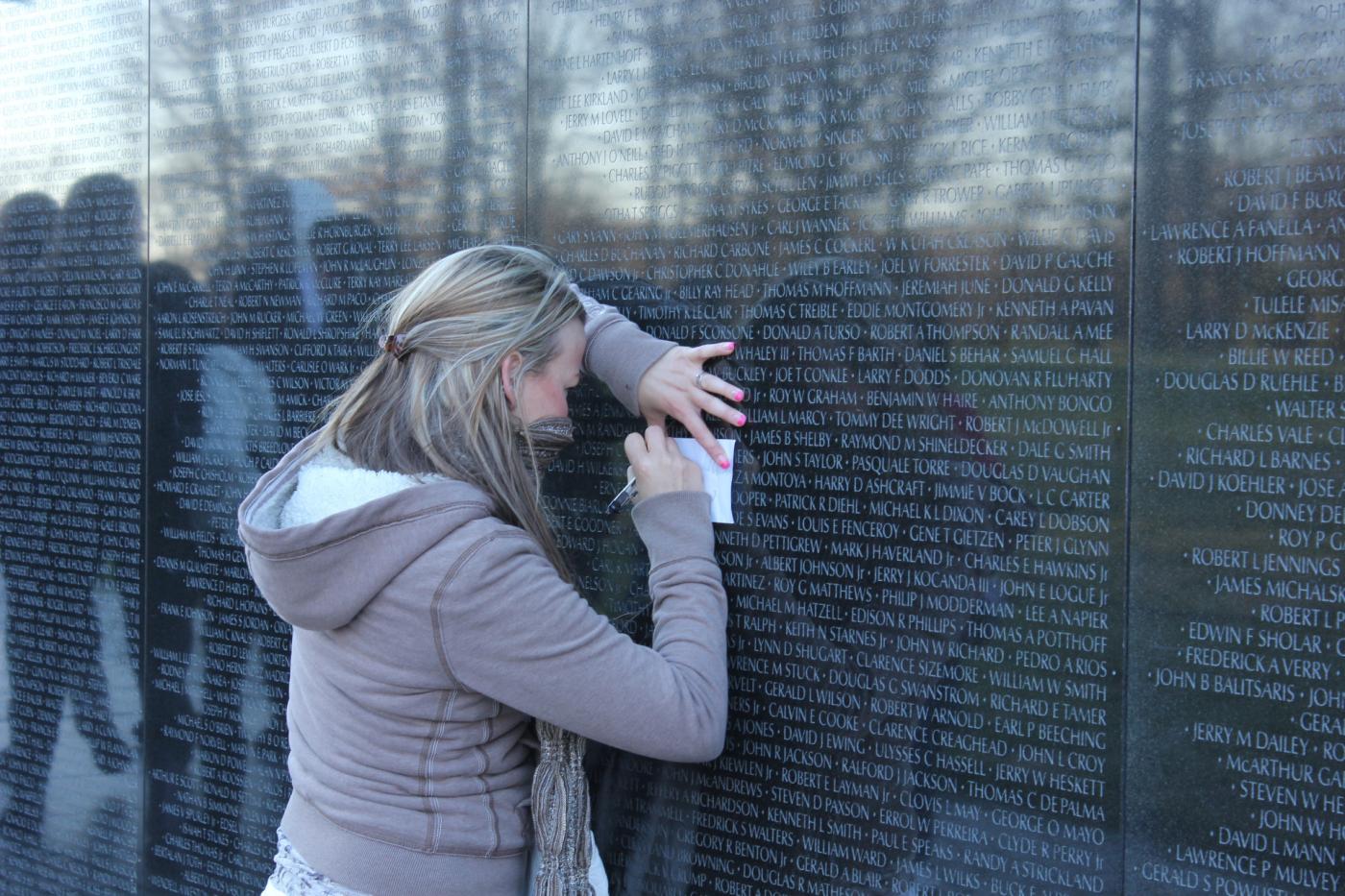
Bruce Wolff, 14, of Canton, Ohio, kneels for a closer look at items left at the Vietnam Veterans Memorial wall. More than 400,000 items have been left since the wall opened in 1982. SHFWire photo by Ian Kullgren
Hidden From View, Offerings at Vietnam Memorial Reveal Nation’s Loss
Nearly 38 years after the war's end, the nation continues to visibly mourn those lost in Vietnam.
Duery Felton doesn’t go looking for things.
War found him at age 19, when he was drafted to be an Army specialist in Vietnam. After a year of fighting the Viet Cong near the Cambodian border, the native Washingtonian returned in 1968 wounded and discouraged.
As a black Vietnam veteran, he was welcomed back with scorn. Washington was still “a really Southern town,” where racism and bitterness from the war ran deep.
Things seem to find Felton. Now 66, he is a head curator of items left at theVietnam Veterans Memorial wall. More than 400,000 items have found their way to his doorstep.
“I look back on my life, and I think about all the things I haven’t been seeking, but have come to find me,” he said.
It’s a massive collection to watch over. The National Park Service stores the items in a cavernous preservation facility 12 miles away in Landover, Md. A small team of historians Felton helps to lead has spent years cataloguing each one, looking for the most telling items to display in an underground museum slated for construction across the street from the memorial wall.

The tradition of leaving items at the wall has taken on a life of its own since it opened in 1982. The first one is rumored to have been a Purple Heart posthumously awarded to a solider – his brother is said to have placed in the wet concrete while the wall was being built, although curators aren’t sure if the story is true.
Now, more items arrive faster than Felton’s team can catalogue them. Endless rows of blue plastic bins keep them safe, sequestered from the rest of the world. Every day, year after year, they pore through memories of the lost.
One man left his medals pinned to a Viet Cong fighter’s shirt.
Another soldier left a flag he took from a Viet Cong soldier he killed in battle and a poem scribbled on a ragged piece of notebook paper, describing how the memory still haunts him.
There’s a banner bashing former President Bill Clinton for avoiding the draft, and a slew of other items protesting Robert McNamara, who was secretary of defense during the war.
And then there are the families. A widow left her son’s high school graduation photo, thanking her son’s dead father for giving her their son. A mother left her dead son’s worn childhood teddy bear.
The smallest items are collected and stored away, even those that seem like trash. There are hundreds of empty beer cans, probably left intentionally, along with troves of baby shoes and Metro transit cards, which likely were dropped accidentally by tourists.
“Some of the things that upset me most are the photos,” museum technician Janet Donlin said. “I know it was the last picture taken of them before they died.”

Leaders of the Vietnam Veterans Memorial Fund, who also headed the construction of the wall, are seeking to tell the war’s story through artifacts. The collection speaks from all sides, including the anger and controversy that divided the nation. Most items are left anonymously. Their back stories are a mystery.
“It’s certainly teaching about the Vietnam War without taking sides,” said Jan Scruggs, president of the Vietnam Veterans Memorial Fund and an Army veteran who fought in the war. “It happened a long time ago. “People still argue about it, and let them.”
Plans for the 35,000 square foot education center, designed by the same firm that drew up plans for Capitol Visitor Center and the Newseum in Washington, will feature a video projection screen with pictures of every soldier whose name is on the wall. The memorial fund put out a nationwide call for veterans and families to send in pictures.
Although the foundation held a symbolic groundbreaking in November, it is not yet clear when construction will begin or when the center will open, Scruggs said. The group has slightly less than half of the money and must meet a 2014 deadline set by Congress.
The price tag is roughly $85 million, although Scruggs said that likely will go up once construction starts.
Newly appointed Secretary of Defense Chuck Hagel, a Vietnam veteran, introduced a bill to authorize construction of the education center in 2000 when he was a senator from Nebraska, but Congress wasn’t convinced. It gathered enough support to pass in 2003, with the requirement that funds would be raised within seven years. In 2010, Congress extended the deadline for four more years and could do so again.
Felton has seen how the items left at the wall change with time. There are fewer handwritten notes, since people mostly type them on a computer. And messages like “John, this would have been our 50th anniversary,” are a reminder of how much time has passed.
Instead of pencil rubbings of the names, people now snap photos with smart phones and tablets. But they still leave things every day for National Park Service rangers to collect at closing time.
Asked whether he’s ever left anything, Felton cracks a knowing grin.
“Everybody asks that,” he said. “It’s a secret.”
Reach Reporter Ian Kullgren at Ian.Kullgren@Shns.com or 202-326-2143.







